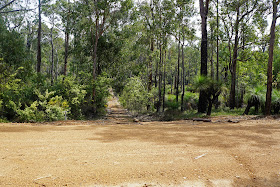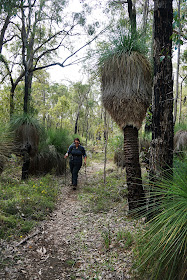Day One of an overnight hike on the Bibbulmun Track, this 30 kilometre day of walking takes hikers from Mumballup to Grimwade via Noggerup. Initially following an old railway line and passing through open farmland, the track then runs through seemingly endless Jarrah forest, ranging from scrappy and thin to virgin old growth. A fairly ordinary day of walking, wildflowers, farmland and the two campsites are the main highlights.
Distance: 30.8 km (one way)
Gradient: A few moderate descents and ascents with some relatively gentle terrain
Quality of Path: Largely clear and well maintained
Quality of Signage: Largely well signed, with the Waugal providing very clear directional information.
Experience Required: Previous Bushwalking Experience Recommended
Time: 8 Hours, including snack, lunch and rest breaks
Steps: Some minor steps
Best Time to Visit: Late Autumn-Early Spring
Entry Fee: No
Getting There: From Collie, Mumballup can be reached via Collie-Preston Rd, while direct access from Perth is best achieved via South Western Hwy to Donnybrook, and then taking Donnybrook-Boyup Brook Rd. No direct access to GrimwadeEntry Fee: No
After 18 years of talking about it, doing a few multiday walks from 2003 and 2012, and just over two years of dedication to ticking off every section of the track, Alissa and I arrived at the car park across the way from the Mumballup Tavern to complete Mumballup to Balingup - the last two days of walking left before we would finally achieve our sectional End to End! It had been a long journey getting to this point, and at 30.8 kilometres, the first day of this overnight hike was set to be one of our longest and most gruelling to date.
From Mumballup, the Bibbulmun turns right and follows an old railway line as it heads west alongside Donnybrook-Boyup Brook Rd. Even at this early stage of the day, the lack of cloud cover and the open nature of the rail trail made for uncomfortably hot walking conditions. Many people had said the weather was going to be 'perfect' for hiking, however I think said people don't understand the best temperatures to be doing everyday tasks in a city are quite different to walking with heavy packs for 30 kilometres. The heat would be a major challenge for the rest of the day; resulting in both of us running out of water before reaching Grimwade.
The railway line continues on almost all the way down Donnybrook-Boyup Brook Rd, however the Bibbulmun turns off the railway line as it reaches a whimsical series of post boxes made from discarded microwaves. At this point, the Bibbulmun briefly enters a section of thin, scrappy Jarrah before heading up the road itself.
The views along this stretch are mostly of farmland, and while it is far from a natural landscape, Alissa and I feel this is a change of pace that the Bibbulmun could do more to embrace more fully. Having done most of Dwellingup to Balingup as a combination of day hikes and overnights has meant we've seen a lot of the countryside in this part of Western Australia. In our opinion, the farmland is really beautiful and in many ways more impressive than most of the endless burnt regrowth Jarrah that dominates the oftentimes featureless walking between Dwellingup and Balingup. While the lack of trees made this fairly hot walking, I would love to see more farmland along this stretch of the track should they ever do a realignment.
After leaving the farmland and passing a Blue Gum plantation, the Bibbulmun enters Preston National Park. At first glance, there was little to recommend of Preston National Park, and I sarcastically joked to Alissa that it was now my favourite National Park - far ahead of perennial favourites like Karijini, Stirling Range and Purnululu.
After a few 100 metres of walking, I had to admit that I was probably being overly harsh, as the open forest floor and yellow wildflower bloom made this one of the better Jarrah forest stretches of walking of the two days.
Continuing along, the forest transitions to more ordinary looking Jarrah forest, complete with a lot of thin young Jarrah punctuated by the odd mature tree here and there.
After some fairly ordinary forest walking, a descent into an ephemeral gully brought us to a lovely natural rock garden with granite outcropping giving the area a charmingly rugged appearance. It was a shame that this section was fairly brief - more of this would have been nice to break up the endless forest walking.
Ascending away from the rocky gully, the trail follows an old railway formation with a short side trail leading to Noggerup hut. Located right near a creek, Alissa and I agreed this was a great location for a campsite and almost wished this was going to be our final hut along the track. Unfortunately for us, this was 7.8 kilometres into our day, and with 23 kilometres to go, we only had time for a quick snack break before heading back on our way.
From Noggerup, the Bibbulmun continues along the railway formation, providing relatively easy going terrain.
The flatness of the terrain was definitely very helpful, however the uninspiring and unchanging scenery made the walking fairly boring, with a change from a rail formation to a vehicle trail being the main notable difference between the previous photo and the one above.
The forest did improve slightly as we came closer to Bennet Rd, with the Bibbulmun passing through more mature Jarrah and Marri. It is a shame that it wasn't in pristine, unburnt condition, but it was nevertheless nice to see taller mature trees rather than thin regrowth.
With so little in the way of change, Bennet Rd was a major landmark, as it signposted that we had walked 12.5 kilometres by this stage.
The walking after Bennet Rd was much of the same Jarrah forest we'd encountered earlier, however this stretch of the track seemed to have the highest number of fallen trees I can recall encountering on a per kilometre basis. While ostensibly following old logging tracks, the trail constantly featured diversions around fallen trees, and Alissa wondered how many kilometres this would all add up to by the time we reached Grimwade.
Another major feature of this stretch of the track was a noticeable increase in Marri growing along the track. I say noticeable as the number of honky nuts was quite insane at times, leading to some fairly uneven walking surfaces that pushed our feet into slightly unusual angles.
All the honky nuts and compacted rail formations/old roads took their toll on our feet, and I was particularly fatigued by the time we stopped for lunch by a Peppermint Tree-lined creek crossing at what was roughly the halfway point for the day. Alissa and I had walked even further when we did Collie to Mumballup a few weeks earlier, however for some reason this day's walking really took it out of me. I usually don't stop to rest very much at all, but by this point I couldn't go two kilometres without needing to stop, let my feet rest and then get going again. To make matters worse, the heat of the day had resulted in us drinking way more water than we usually do. On average, Alissa and I only drink about 1.5 litres during a day of walking, however we probably needed three or more litres for this day. Having only had our customary 2 litres on us, we both ran out of water not long after lunch.
Beyond the creek crossing, the Bibbulmun entered an area of virgin Jarrah. Seeing some tall Jarrah along this stretch made me deeply regretful for the folly of earlier generations who chopped down so much of the old growth Jarrah forest in such an unsustainable manner. The scrappy, thin trees we see today are but a poor imitation of what was here before European settlement, and the climate drying out, it will only get worse.
It was not just the Jarrah and Marri that were impressively large in this old growth section of forest - the Grass Trees were impressively large too.
Finally, after 5.5 hours of walking, Alissa and I reached Lowden-Grimwade Rd - the next Bibbulmun access point. This was the most important landmark for us, as it meant we now only had 10.3 kilometres to go before reaching Grimwade campsite.
After Lowden-Grimwade Rd, the track follows a distinct railway formation through some ugly blackened Jarrah. Although the trail would change from rail formations to roads to single file walking track, the surrounding forest was much the same for the seven kilometres from Lowden-Grimwade Rd onwards.
After ascending and descending three hills, the track rises up one final hill before a longer descent into a gully. At this point, there was an obvious change in foliage, with the Jarrah and Marri featuring a dense understorey of Karri Hazel.
The wildflower display in the gully was quite impressive; while we'd seen wildflowers throughout the day, they had not been as brilliant as they were here. After the gully, Alissa and I began our last major ascent of the day.
The wildflowers in the gully had been impressive, but what we discovered up the next hill was an unprecedented display of Flame Peas and Wattle blooming by the side of the track. This was arguably one of the most impressive wildflower displays we had seen over our entire sectional End to End, and a nice surprise after a day that largely consisted of charcoal, fawn, grey, army green and khaki.
After enjoying the wildflowers, the Bibbulmun descended steeply. At the bottom of the descent, we were surprised to find the track rise slightly before leading to a junction in the trail, with the hut located 300 metres to the left.
Overlooking a lovely valley, Grimwade is one of the rare 'Stretch'-style huts along the Bibbulmun Track, featuring wider bunks than the Standard style hut but with the same table in the middle of the main space. Alissa and I had arrived fairly late in the afternoon, and another hiker had already arrived from the other direction early in the day. We would later discover she was doing her fourth End to End!
Being our last overnight on the track, I have to admit I was hoping for more from Mumballup to Grimwade. While I expected the day to be long and challenging, it didn't help that the scenery from Noggerup onwards was pretty much the same from start to finish - I could easily put the forest photos in a different order and they could be used almost interchangeably. I've come to the conclusion that I just don't like Jarrah forest that much, or at least what the Jarrah forest has become - thin scrappy trees that are all invariably covered in char marks from previous fires (controlled or otherwise). At least there were some lovely moments throughout the day, with the farmland near Mumballup, the first kilometre in Preston National Park, the impressive wildlfowers towards the end and the areas around both Noggerup and Grimwade being highlights.
And with that long day done, we only had Grimwade to Balingup standing between us and successful completion of the entire track!



























No comments:
Post a Comment